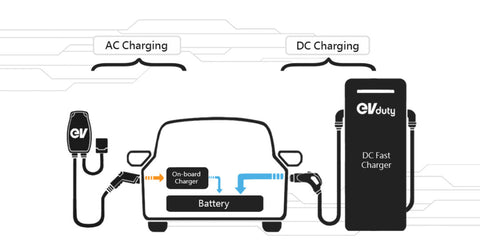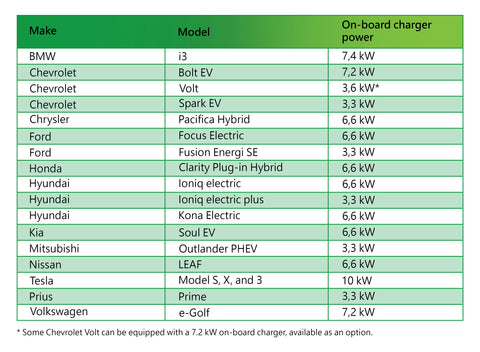Why is my charging station not delivering its maximum power?
The EVduty charging station provides a maximum power output of 7.2 kW (208-240VAC, 30 amps). However, it is the vehicle equipment that regulates power while charging. Indeed, the power of what is called the “on-board charger” varies from one vehicle to another. This equipment receives alternating current (AC) from the charging station and converts it to direct current (DC) to recharge the battery. All-electric vehicles are usually equipped with a more powerful on-board charger (6.6 kW and more) whilst plug-in hybrids often have a less powerful charger (3.3 to 6.6 kW).

Here is a table showing the on-board charger power of some plug-in vehicles available on the market:
The power of the on-board charger informs us of the maximum number of kWh that can be transferred into the battery per charging hour at 240V. This thus influences the duration of charging sessions. For example, when fully charging a battery with a capacity of 20 kWh: A vehicle with an on-board charger of 3.3 kW will be full after charging for 6 hours (20 kWh divided by 3.3 kW) while the one with a 6.6 kW on-board charger (20 kWh divided by 6.6 kW) will be full after 3 hours.

If you have a smart EVduty charging station (Smart-Home), you can check the mobile app during charging to see the delivered power. In addition to the power of the on-board charger, a few other factors may induce a reduced power. Thus, if the EVduty app indicates that your vehicle is charging at less than 7.2 kW, the five most plausible explanations are as follow:
- Your vehicle’s on-board charger has a maximum power of less than 7.2 kW
- Your charging station has been configured to limit power (for example, in the case of an installation on a circuit of less than 40 amps).
- Your EVduty charging station is configured for power sharing with a 2nd EVduty station and two vehicles are charging at the same time.
- Your vehicle’s battery is full (or nearly) and battery optimization is active.
- There is a variation in the distribution network’s voltage *.
* At 240V, a 30 amp charging station can provide a maximum power of 7.2 kW (240V x 30A) but at 208V, the power is limited to 6.2 kW (208V x 30A). Voltage variations may occur during peak periods or during a high power demand.

Leave a comment